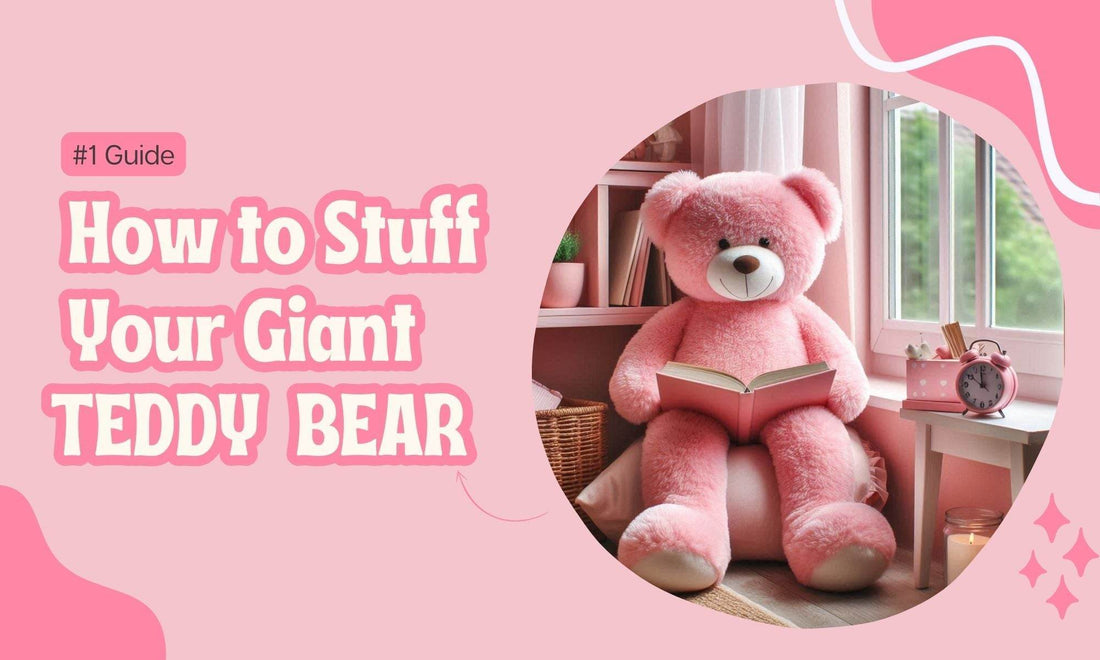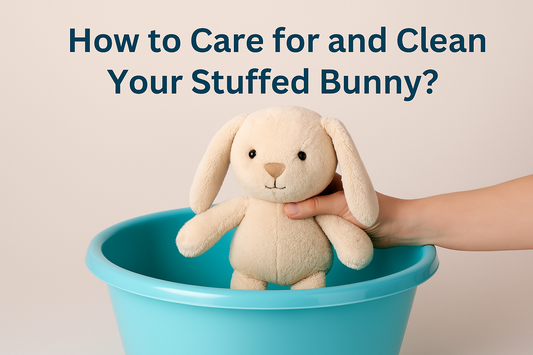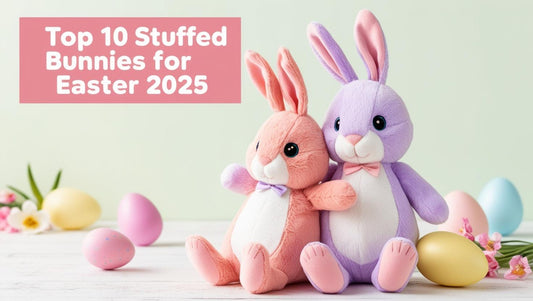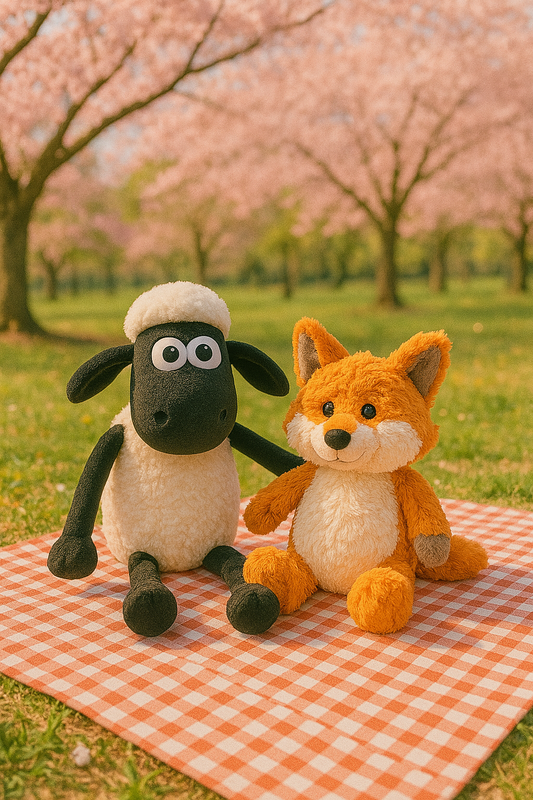At Goodlifebean, we’ve designed and created over 1000+ plushies and giant teddy bears over the past four years. Through our journey, we've learned the ins and outs of plush perfection, including one of the most crucial aspects: teddy bear stuffing. Whether you're looking to stuff a new plushie, re-stuff an old favorite, or give your giant teddy bear a little extra love, this guide will help you understand everything there is to know about stuffing.
Teddy bears and other stuffed animals bring comfort, joy, and warmth to people of all ages. But have you ever thought about what goes inside these cuddly companions to make them so huggable? That’s right—it’s all about the stuffing! In this blog post, we’ll dive into the fascinating world of teddy bear stuffing. We’ll cover the different types of stuffing, how to stuff or re-stuff your plushie, where to find stuffing, and much more. Whether you’re creating a plush from scratch or simply want to refresh your favorite teddy bear, this guide will have you covered.
Types of Teddy Bear Stuffing
Stuffing is a crucial element when it comes to plush toys and teddy bears. The type of stuffing you use impacts not only how the toy feels but also how it holds up over time. Let’s look at some common types of stuffing you’ll find in stuffed animals, including giant teddy bears.
1. Polyester Fiberfill
Polyester fiberfill is one of the most commonly used materials for stuffing teddy bears and stuffed animals. It’s a synthetic material that’s soft, fluffy, and provides a lot of volume without being too heavy. It’s non-allergenic, making it ideal for children’s toys, and it holds its shape well, making it perfect for giving your plushie that perfect huggable form.
Best for: Everyday plushies and large teddy bears.
Where to find it: Craft stores, online retailers, and fabric shops.
2. Cotton
Cotton is a natural stuffing material that’s soft, breathable, and hypoallergenic. While it’s not as bouncy as polyester, cotton has a more natural feel and is perfect for eco-conscious individuals who want to avoid synthetic materials. However, cotton can become compacted over time and may need to be re-fluffed or replaced.
Best for: Small or medium-sized plushies that aren’t frequently used.
Where to find it: Organic craft suppliers or specialty stores.
3. Foam
Foam stuffing provides a firm structure and is often used in specific parts of a teddy bear or plushie, such as the head or feet. It helps maintain a toy’s shape and is great for people who prefer a more solid stuffed animal.
4. Memory Foam
Memory foam stuffing is increasingly popular for body pillow-style plushies or plushies designed to offer more ergonomic support. It molds to the shape of the user and offers a more therapeutic comfort. This type of stuffing is often used for plush toys designed for adults, including large teddy bears or body pillows.
Best for: Plushies that are also used as pillows or back support.
Where to find it: Home goods stores and specialty retailers.
5. Bean Bag Pellets
Small plastic or foam pellets are sometimes used in the bottom or limbs of stuffed animals to provide weight and stability. Pellets give a plushie a more “bean bag” feel and are perfect for making your teddy bear sit upright.
Best for: Larger teddy bears or plushies that need structure.
Where to find it: Craft stores, toy suppliers, and online shops.
6. Wool
Wool is a traditional stuffing material that’s biodegradable, sustainable, and naturally resistant to dust mites and bacteria. It’s a bit firmer than polyester or cotton, and while it holds shape well, it can get lumpy over time if not stuffed properly.
Best for: Eco-conscious buyers and plushies for sensitive skin.
Where to find it: Specialty craft stores and online eco-retailers.
7. Recycled Materials
Many manufacturers now use recycled polyester fiber or cotton in the making of teddy bears. These eco-friendly stuffing options are a great choice for reducing waste while still enjoying a soft and plush teddy bear.
How to Stuff a Teddy Bear or Plushie
Stuffing your own teddy bear or plushie can be a fun, rewarding experience, and it gives you the ability to control how firm or soft your toy will be. Whether you're sewing a new teddy bear or re-stuffing an old one, here's how to do it step by step.
Materials You'll Need:
- Teddy bear or plushie (either sewn or ready to be stuffed)
- Polyester fiberfill, cotton, or your chosen stuffing
- Stuffing tool or chopstick (for reaching small areas)
- Needle and thread (if you’re re-stuffing and need to sew parts back up)
- Optional: Bean pellets or foam for added structure
Step-by-Step Guide to Stuffing:
1. Prepare Your Plushie: If you’re sewing a plushie from scratch, leave a small opening at the bottom or back for inserting the stuffing. If you're re-stuffing an existing bear, carefully open a seam using a seam ripper.
2. Start with Limbs and Ears: Use small amounts of stuffing to fill the arms, legs, and ears first. Use a chopstick or a stuffing tool to push the material into the smaller parts of the teddy bear.
3. Fill the Head: After the limbs are stuffed, move on to the head. Use enough stuffing to keep the head firm and round, but avoid overstuffing as this may stretch the fabric.
4. Stuff the Body: Gradually stuff the body of the bear or plushie. If you're using a combination of materials like foam and polyester, insert the foam into the body first for structure, then surround it with polyester stuffing for a soft, fluffy feel.
5. Adjust for Firmness: Depending on your preference, you can adjust how firm or soft your teddy bear will be. For a softer plush, use less stuffing, and for a firmer one, pack in more stuffing.
6. Close the Seam: Once you’ve filled the plushie to your satisfaction, carefully sew the seam closed with a needle and thread. Make sure to use strong stitches to prevent the stuffing from coming out.
When to Stuff or Re-Stuff a Teddy Bear
Even the most well-loved teddy bears sometimes lose their fluffiness over time. Here are some signs that it’s time to re-stuff your teddy bear or plushie:
Signs You Need to Re-Stuff:
- Flattening: If your teddy is losing its original shape or looks deflated.
- Lumpy Texture: Over time, some stuffing materials may clump or shift, resulting in lumps.
- Excessive Wear: When your teddy’s been hugged a little too hard over the years, it might start to sag or look worn out.
- Loose Seams: If your bear’s seams have opened, that’s a sign it might be time for a fresh re-stuff.
How to Re-Stuff a Teddy Bear After Washing
If your teddy bear has been through the wash and needs a little extra TLC, re-stuffing is the perfect solution. Here’s how to do it:
1. Dry Thoroughly: Make sure the teddy bear is completely dry before re-stuffing. You can air-dry it or use a low-heat dryer setting.2. Remove Old Stuffing: If the stuffing has become matted or worn, carefully open the seams and remove it.
3. Clean the Bear's Outer Fabric: Before re-stuffing, ensure that the outer fabric of your teddy bear is clean. Use a lint roller or a damp cloth to remove any lint or dirt.
4. Stuff Again: Follow the steps mentioned above to re-stuff the bear with fresh filling, ensuring that you evenly distribute the stuffing for a plump and huggable look.
5. Sew Up: Once the bear is back to its full size, close up the seams with strong stitching.
Where to Find Teddy Bear Stuffing
You can find teddy bear stuffing materials at most craft stores, online retailers, or specialty toy-making shops. Here are some popular options:
- Craft Stores: Stores like Michael’s, Joann’s, and Hobby Lobby usually carry polyester fiberfill, cotton stuffing, and other materials.
- Online: Websites like Amazon, Etsy, and specialty toy-making sites have a wide selection of stuffing materials, including eco-friendly and hypoallergenic options.
- Teddy Bear Repair Shops: If you have a special teddy bear that needs re-stuffing, many teddy bear repair shops offer professional re-stuffing services.
- Eco-friendly suppliers: If you're opting for sustainable stuffing like wool or bamboo, you can find eco-friendly suppliers online or at specialty craft markets.
FAQs About Teddy Bear Stuffing
Are stuffed animals machine washable?
Many stuffed animals are machine washable, but always check the care label. Some plush toys may only be suitable for surface cleaning, while others can go into the washing machine on a gentle cycle. Be cautious with plushies that contain delicate stuffing like foam or pellets.
How much stuffing do I need for a giant teddy bear?
A large 6ft teddy bear may require several pounds of stuffing, depending on its size and how firm you want it to be. Typically, for a plush of this size, you may need between 5-10 pounds of polyester fiberfill.
How often should I re-stuff a teddy bear?
It depends on how much wear and tear the teddy bear experiences. If your bear is frequently used, especially by children, you may need to re-stuff it every few years or as needed.
What’s the best way to store a giant teddy bear?
If you're storing a giant teddy bear, keep it in a large, breathable bag or box in a cool, dry place. Avoid compressing the bear for long periods to maintain its shape.
Is eco-friendly stuffing more expensive?
It can be slightly more expensive than synthetic materials, but it's a great option for eco-conscious consumers and those with sensitive skin.
Final Thoughts
Teddy bear stuffing may not be something you think about every day, but it plays a crucial role in making your plushie the perfect cuddle buddy. Whether you’re stuffing a bear from scratch, re-stuffing an old friend, or learning to maintain your giant teddy bear’s fluffiness, knowing the right materials and techniques can ensure your plushie stays soft and comforting for years to come. Happy stuffing!
















